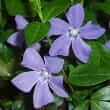Background
- Periwinkle (Vinca spp.) and Madagascar periwinkle (Catharanthus spp.) are both members of the Apocynaceae family. Madagascar periwinkle was formerly classified as a Vinca species (Vinca rosa) but is now classified as a separate species. The two are similar in appearance and are both commonly referred to as "myrtle."
- Lesser periwinkle is commonly cultivated for use as ornamental ground cover, though it is considered an invasive weed in some areas of North America and Australia. Madagascar periwinkle is also commonly used as an ornamental plant but thrives only in a subtropical environment where temperatures do not fall below 41ºF (5ºC).
- Both species produce alkaloids that have been studied and used as a treatment for treatment of a wide variety of conditions, including diabetes, cancer, hypertension (high blood pressure), and stroke.
- The use of periwinkle as a dietary supplement is not recommended, because it contains vinca alkaloids, which may cause damage to the liver, kidneys, and nerves, as well as death.
References
- Csomor, K. and Karpati, E. Effect of vintoperol on platelet aggregation and experimental thrombosis. Arzneimittelforschung. 1994;44(1):36-40. View Abstract
- Filippini, R., Caniato, R., Piovan, A., et al. Production of anthocyanins by Catharanthus roseus. Fitoterapia 2003;74(1-2):62-67. View Abstract
- Foldi, M., Obal, F., and Szeghy, G. [On the effect of Devincan (Vinca minor alkaloid) on the EEG and the fundus oculi pattern in patients with cerebral sclerosis]. Med.Welt. 9-11-1965;37:2122-2124. View Abstract
- Ghosh, D., Roy, I., Chanda, S., et al. Allergy to periwinkle pollen (Catharanthus roseus G. Don.). Ann.Agric.Environ.Med. 2007;14(1):39-43. View Abstract
- Jordan, M. A. and Wilson, L. Microtubules as a target for anticancer drugs. Nat.Rev.Cancer 2004;4(4):253-265. View Abstract
- Kidd, P. M. A review of nutrients and botanicals in the integrative management of cognitive dysfunction. Altern.Med.Rev. 1999;4(3):144-161. View Abstract
- Krainer, M., Tomek, S., Elandt, K., et al. A prospective, open label, randomized phase II trial of weekly docetaxel versus weekly vinorelbine as first line chemotherapy in patients with androgen independent prostate cancer. J.Urol. 2007;177(6):2141-2145. View Abstract
- Leveque, D. and Jehl, F. Clinical pharmacokinetics of vinorelbine. Clin.Pharmacokinet. 1996;31(3):184-197. View Abstract
- Mans, D. R., da Rocha, A. B., Schwartsmann, G. Anti-cancer drug discovery and development in Brazil: targeted plant collection as a rational strategy to acquire candidate anti-cancer compounds. Oncologist. 2000;5(3):185-198. View Abstract
- Nakabayashi, M., Ling, J., Xie, W., et al. Response to vinorelbine with or without estramustine as second-line chemotherapy in patients with hormone-refractory prostate cancer. Cancer J. 2007;13(2):125-129. View Abstract
- Osujih, M. Exploration of the frontiers of tradomedical practices: basis for development of alternative medical healthcare services in developing countries. J.R.Soc.Health 1993;113(4):190-194. View Abstract
- Rosazza, J. P., Duffel, M. W., el-Marakby, S., et al. Metabolism of the Catharanthus alkaloids: from Streptomyces griseus to monoamine oxidase B. J.Nat.Prod. 1992;55(3):269-284. View Abstract
- Szatmari, S. Z., Whitehouse, P. J. Vinpocetine for cognitive impairment and dementia. Cochrane.Database.Syst.Rev. 2003;(1):CD003119. View Abstract
- Verma, S., Wong, N. S., Trudeau, M., et al. Survival differences observed in metastatic breast cancer patients treated with capecitabine when compared with vinorelbine after pretreatment with anthracycline and taxane. Am.J.Clin.Oncol. 2007;30(3):297-302. View Abstract
- Wu, M. L., Deng, J. F., Wu, J. C., et al. Severe bone marrow depression induced by an anticancer herb Cantharanthus roseus. J.Toxicol.Clin.Toxicol. 2004;42(5):667-671. View Abstract







